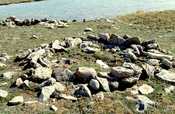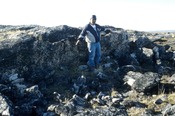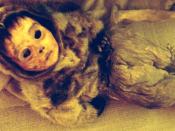YEAR 11 ASSESSMENT TASK
HUMAN REMAINS
The Inuit Mummies of Greenland
Qilakitsoq is a remote spot on the west coast of Greenland, about 450km north of the Artic Circle. Thule Culture, (named by Archaeologists) which originated in Alaska and then spread westward about a thousand years ago, occupied this spot. The Thule Culture are the ancestors of the modern day Inuit, who still inhabit the Arctic. Qilakitsoq was a winter encampment, comprising a number of stone and turf structures.
In October 1972, two brothers, Hans and Jokum Gronvold, were out hunting close to this deserted Inuit settlement when they came across a natural rock overhang about 200m from the closest structure. In the crevice was an unusual shaped pattern of stones, and on removing these stones the Gronvolds found the mummified remains of six women and two children laid to rest in two separate graves. While the rock overhang protected the graves from direct sunlight and the effects of rainfall and snow, the bitter cold and icy winds meant that these bodies had effectively been freeze-dried after death.
As a result, their tissues and clothes had hardly deteriorated. Although they reported their finds immediately to the authorities, it was only in 1977 that Jens Rosing, the new director of the Greenland Museum comprehended their significance and transported them to Copenhagen for further analysis by the pathologist J.P Hart Hansen and the archaeologists Jorgen Meldgaard and Jorgen Nordqvist. The "Greenland Mummies" as they came to be referred to as, were the best-preserved human remains ever found in North America.
The mummified bodies had been stacked on top of each other, five in one grave and three in the other. They were all dressed in warm clothing made of sealskin, consistent with the traditional Inuit belief that the journey to...


